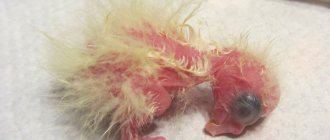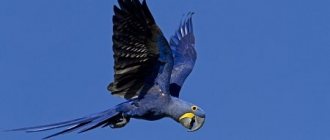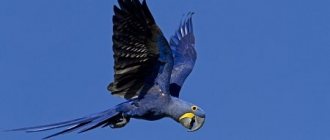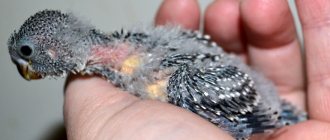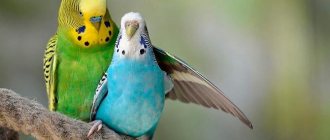Many owners of cockerels care not only about their health, but also about the favorable mood of their pet, and in order not to get bored, they often buy a second parrot of the opposite sex. Naturally, the coexistence of two birds can lead to the appearance of chicks in the house. This event is not only shrouded in joy, but also do not forget that birds need special care and attention at this time. To raise a healthy and strong chicken, appropriate conditions must be created, and the entire process can take about a month and a half.
What do cockatiel chicks look like?
In the first days of life, newly hatched rooster chicks are completely helpless and bring a lot of emotions to their owners. The small featherless plumage tries to connect with the outside world. This vulnerable creature requires not only parental attention, but also the supervision of the owner. The appearance of future proud birds will vary greatly depending on the stage of development. Owners will be able to witness the magic of this metamorphosis - from a small defenseless creature, barely covered in fluff, to an adult and curious teenager who takes on the behavior of his parents.
Selection rules and price
Of course, not everyone is ready to breed corlie chicks on their own, but when buying a bird from a breeder, you should not forget about some features. The appearance of the chick, its condition and stage of development play a key role if the future owner plans to have a healthy pet.
How to choose a healthy parrot
One of the first signs of the breeder’s skill and hard work is the condition of the chickens, as well as the conditions of their keeping, the condition of the cage and its contents. Water and food bowls should be kept clean and young birds should be kept separate from older ones. You can easily determine the age of a parrot by paying attention to the length of its plumage, including its comb. Another feature of chickens is the dark, almost black color of the pupils, which only become brown with age. If the bird is healthy, it not only has a pleasant appearance, but also active behavior. Even young correls are very active and curious, often showing interest in newcomers.
How much do cockatiel chicks cost?
The average cost of a young cockerel in rubles is approximately 2500-3500 thousand rubles. The price may be influenced by the appearance of the bird and its pedigree, but most breeders adhere to similar pricing policies.
What not to give
So, we figured out what to feed cockatiels at home. There is also a list of foods prohibited for birds. You cannot give food from the common table, including salted, fried, smoked food.
What foods are bad for parrots?
- spicy herbs, garlic, onions;
- persimmon, avocado;
- candied fruits;
- potato;
- seafood;
- canned food;
- candies, chocolate;
- fatty cheese;
- mushrooms;
- sausage;
- salted cucumbers.
Note! Bread, cookies, and crackers can be given rarely and in small quantities if the bird likes them. Spikelets of chumiza and specially prepared honey sticks are also allowed, but only as a delicacy, and not for everyday food.
Conditions of detention
Before you go for a new pet, you should organize a place to live for it, taking care of all the amenities in advance. Place the nursery in a room with a suitable temperature of 23 to 24 degrees Celsius. Let's not forget that the cockatiel's cage must be spacious enough so that the bird can move freely in it, spreading its wings. The average cage dimensions start from 60 cm in height and 50 cm, the depth of the cage should be at the same level. The more spacious the living space, the better the parrot will feel.
After the new pet has settled in, it is necessary to provide it with constant access to water and refresh the liquid if it has been in the drinking bowl for a long time. The cage should be wiped down every few days, dust and dirt can cause great harm to health, and do not leave the bird in a place that is too dark or sunny.
Cockatiels are incredibly clean creatures and love to clean their feathers, so they don't need to be washed at all. Alternatively, you can leave the chicken in a small bath of water to make this process easier. You can dilute a small amount of soap in water, but cleaning their feathers is not necessary. To avoid injury, the claws can also be trimmed like an adult bird, but such a procedure can provoke the development of stress.
Diet in the wild
The natural habitat of cockatiels is the forest-steppe zone of Australia. In the places where these parrots live, eucalyptus and fruit trees, low shrubs, and dense grass grow. Such conditions determine the diet of the cockatiel: the predominance of plant food in the form of seeds, fruits, and succulent grassy shoots. In addition, birds feed on nectar, tree resin, and tear off the tender bark from the branches. They catch insects in the air and hunt crawling creatures: even tiny lizards sometimes become victims of attentive cockatiels.
Parrots drink water from rivers and lakes, flying to the surface of the reservoir and grabbing a few sips. It is dangerous for birds to drink near the shore: predators may be hiding there. When there is a lack of water, cockatiels save themselves by drinking the morning dew.
When times get tough, rivers dry up and crop yields decline, flocks of birds raid farmland. Hunger forces them to look for food near humans: fields with grain crops are subject to massive destruction. In the fight against winged pests, people go to extreme measures: they catch birds with nets, poison them with pesticides, and shoot them.
Why a chick may die and how to prevent it
Even such a joyful moment as the arrival of a new friend in the house can easily be overshadowed by the sudden appearance of a dangerous illness. Unfortunately, all animals, and especially babies, are very vulnerable to external influences.
If you breed birds yourself, the cause of death may be the parents' rejection of the chick, in which case the owners will have to resort to artificial feeding. Always keep a close eye on the cage environment to ensure the chick is not pushed out. If you notice that adult birds are harming your baby, move them away and take care of them yourself.
Another reason may be infectious diseases; still weak immunity is sensitive to various bacteria. If your chicken exhibits unpleasant symptoms such as gas, decreased appetite and general depression, contact your veterinarian immediately to rule out serious consequences.
Improper care can also lead to the death of your pet, so do not place the cage in a room that is too warm or cold. Many parrots are prone to stress, and you can provide temporary shelter for your little guest by placing a small house in a cage.
Reviews
Most bird lovers have a very positive attitude towards breeding a breed such as cockatiel. These birds are quite intelligent, can often learn a few words, and their owners will be happy to find real friends. Do not forget that these beauties tend to experience stress in the absence of the owner, so you should not get them if you like long trips. A Corella parrot can bring many bright and interesting moments into your life; In addition, they have a fairly long service life. All this makes them a favorite breed among breeders.
Daily norm
A couple of level tablespoons of grain mixture or, to put it another way, 40 grams will be enough per day. If you are planning a grain-based treat - honey briquettes, then the amount of grain food needs to be reduced, because otherwise you risk feeding your pet. During the period of active growth and hatching of offspring, the norm can be increased to 60 grams.
It is advisable to feed the bird 2 times a day to avoid overeating.
Please note that in natural conditions, individuals are awake for 15 hours, while being in active movement. Therefore, if the daylight hours are short, it is necessary to take care of artificial lighting since the cockatiel does not eat in the dark. If the daylight hours are not artificially lengthened, there is a risk that the parrot may become exhausted.
How to choose a healthy pair for breeding
Selecting a suitable breeding pair begins with purchasing the birds. Healthy parents produce healthy offspring, so choosing a cockatoo should be taken very seriously.
Buy parrots from reputable breeders or breeders. There, their age will most likely be known, and you can be sure that the birds were kept in the right conditions and fed quality food. Read more about choosing a cockatiel parrot in this article.
When the birds take up residence in your home after purchase, keep an eye on them. If you notice that the cockerels have chosen each other over other birds in the aviary, it is better to take this pair for breeding.
In nature, they choose their partners independently, so at home they should be guided by the same principles.
If you only have one parrot, choosing a mate will be more difficult. It is unknown how the animal will react to the appearance of its chosen partner and how they will like each other.
Therefore, do not rush to put it in a cage until your pet has just bought a parrot. Let them get used to each other a little.
The habituation process is quite simple: place the birds in different cages and place them next to each other. They will get used to each other in a few days.
Attention! A newly purchased parrot should not be introduced to a long-term partner earlier than two to three weeks after meeting.
If we find that the birds are not reacting aggressively towards each other, but, on the contrary, are showing interest, they can make a good pair.
It is important that they are healthy at this stage, otherwise the offspring of sick parrots will cause a lot of trouble later.
Once they are placed together in an aviary or cage, the bettas can begin grooming each other, feeding their mate, and engaging in mating behavior. The breeding season has arrived. You will need to prepare the nest box and change your diet by increasing the amount of animal products, adding mineral supplements and sprouting grains.
Preparation for breeding
After the family union is formed, the next step is preparatory actions. Interestingly, the breeder can plan the breeding of parrots independently. It is not so difficult to push birds to procreate; it is enough just to provide them with all the conditions. For breeding, cockatiels need the right diet and a comfortable nest. But first of all, you should consider when - in summer or winter - it will be easier for birds to produce offspring.
Timing for mating
Tame cockatiels, unlike wild ones, can breed at any time of the year. Breeders have determined the optimal period for breeding - from May to October. The summer-autumn season has long daylight hours and an abundance of fresh vitamin products. Under such favorable conditions, the breeding of cockatiels will be more effective.
Attention! With a lack of natural light, the bird’s body lacks sex hormones. By gradually increasing the length of the day, the owner helps the birds mature for mating.
The natural instinct of nesting awakens in birds long before the appearance of the first egg. To breed tame cockatiels, you need a nesting house, when the female sees it, she understands that the time has come.
Nest house
So, the nest serves as an incentive for breeding. What should it be like? In nature, cockatiels nest in hollows closed on all sides, where there is only one hole. This is an indicator that birds need to hide from prying eyes. You can see how two cockatiels mate, but hatching the eggs is a mystery. The owner, expecting offspring from his charges, must provide them with a cozy nesting place - a box or nest box. You can buy it at a pet store or make it yourself.
It is important to know! It is not recommended to use plywood and chipboard during construction, as they contain harmful resins. Suitable material for the house is deciduous wood boards. Coniferous species cannot be used - they have a strong odor.
The tree traps noise and heat, and the cockatiel feels protected in such a nest. According to the design of nesting boxes, there are horizontal and vertical ones. The first has a much larger bottom area, which is very good - there is enough space for everyone. The convenience of the second option lies in the high-lying entrance, so that the chicks cannot fall out of the nest.
A good house meets the following requirements:
- minimum dimensions: length and width 40 cm, height – 30 cm;
- entrance on the side of the front wall: round, corresponding to the size of the bird;
- a perch under the entrance outside and a long step inside so that the bird does not fall into the house;
- a depression in the bottom to prevent the eggs from rolling out;
- removable or hinged cover.
A layer of dry sawdust and planed branches is poured into the finished nest. Holes are made in the lid or walls for ventilation. The house is fixed to the outside of the cage, and if the birds live in an aviary, they are placed inside on a hill. The nesting box should not be placed too high, otherwise the young individual will fall and break during its first flight.
Diet
Proper feeding of cockatiels during the preparation period is the key to success during breeding. Even in early spring, you need to start feeding the birds with healthy foods:
- sprouted wheat;
- nuts;
- boiled egg;
- fruits;
- grated carrots.
It is necessary to add calcium supplements to food and additional vitamin and mineral supplements. The cage should always have fresh twigs, sepia, and chalk. The grain mixture is in factory packaging marked “for the nesting period.”
The appearance and development of cockatiel chicks
After 21-23 days from the moment the first egg is laid, the chicks hatch one at a time. They are hatched blind, covered with delicate yellow down, weighing only 4-5 grams. Over the next week of life, they gain weight and become four times heavier, weighing 20 grams. This is also the time when they begin to squeak urgently when they are hungry. At this time, parents constantly warm their chicks, since due to the lack of plumage they are very sensitive to temperature changes and can get sick and die.
The eyes of young cockerels open after 10 days of life. By this point, they already weigh 40 grams, hold their heads well and make loud clicks or squeaks. At the same time, the seeds of the developing plumage begin to appear under the fluff of the newborn.
Important: banding of young roosters is carried out approximately on the tenth day of life.
On the 14th day, the rudiments of a typical comb appear on the heads of young roosters. The beak begins to resemble the beak of an adult. The chicks already weigh 80 grams.
If at first they squeaked when they were hungry, then a little later the sound became “squeaky”, it became similar to knocking or snoring. Hungry babies make a lot of noise.
All this time, the parents feed the chicks first with goat's milk, and then, when milk ceases to be produced, with partially digested food.
By 20-21 days of age, the yellow coating from the bird’s body is completely removed. Their glances are already meaningful and curious. Chicks try to imitate the behavior of their parents.
The following week, their chicks are fully feathered - their crests lengthen, the entire surface of their body is covered with feathers, and characteristic orange-red spots appear on their cheeks. The seedlings begin to peck out seeds and grains, which means they can feed themselves.
As soon as month-old birds begin to make their first attempts to fly out of the nest. At about six months of age they leave the nest forever. The parents feed the chicks for about 2 more weeks until they can completely do without them.
Egg laying and brooding period
By organizing the necessary climate and hanging a nesting house, you will stimulate the reproduction of cockatiels. The mating period of parrots lasts seven to ten days, in rare cases - about a month. After about ten to fourteen days, or a little later, the first testicle appears. Before laying an egg, the female begins to noticeably worry, her breathing quickens.
The female lays an egg per day or every other day. As a result, the clutch should contain from three to seven eggs. When the female lays her second or third egg, she and the male take turns incubating them. The laying period sometimes reaches ten hours, during which time the male warms the clutch.
From time to time, the female turns over and rearranges the eggs so that the chicks do not stick to the wall of the shell and warm up evenly. The female rarely leaves the nest to go to the toilet and have a snack. The rest of the time she is fed by the male.
In about twenty-one days the first chick should appear. You will know this by the characteristic squeak. In whatever order the female laid her eggs, the babies will appear in that order.
Start cleaning the nesting house only two weeks after the last chick hatches. If parents show aggression, it is better to postpone cleaning. Excessive worry will only harm cockatiels and their babies.
Foster chicks
It happens that some female cockerels do not have maternal instinct and do not begin to feed the chicks after hatching. Babies can survive for several hours without food, but if the fasting period is prolonged, they are at risk of dying.
If the female does not start feeding the chicks and you have several more bettas, try placing the eggs in another nest. If the female refuses to eat the chicks there too, be prepared to feed them yourself. To do this, you should prepare a special mixture for babies. It should not be thick and have a temperature of + 36-37 ° C.
Take your parrot, place it with its back facing you in the palm of your hand and place a drop of the mixture on its beak. If the chicken is not too weak, it will easily swallow it.
Feed these chicks every 2 hours, even at night. Only after seven days can you switch to feeding at three-hour intervals and completely stop feeding at night (22.00-6.00). The amount of food will have to be gradually increased.
At two weeks of age, the fry are fed fine millet porridge and baby porridge formula.
By the age of three weeks, coral chicks are already accustomed to eating food with their beaks from a spoon or other container. And the older they are, the better they get at it.
Formula options
Making a mixture for Corley chickens is easy. There are several food recipes for these babies, you can choose any of them:
Feed rate per day
The cockatiel is a medium-sized parrot and can eat approximately 30g of food per day. This is the total amount for an adult: 2 teaspoons of grain mixture, succulent food, grass. If the bird does not empty the feeder during the day, you need to reduce the portion. Feed poured in the morning should not be left overnight. It is thrown away, the feeding container is cleaned and a small amount of dry assortment is added before bedtime so that the pet can satisfy its hunger after waking up.
It is quite difficult to feed such a picky bird as a cockatiel. She is also suspicious of colored granules in ready-made mixtures, and unfamiliar fruits, vegetables, and foods with an unusual smell. And yet, an impressive list of what you can feed your cockatiel allows you to create a complete diet, healthy and nutritious.
When can cockatiel chicks be removed from their parents?
Typically, parents feed their offspring for two months. However, sometimes the female can produce new litters, and then feeding ends earlier.
In this case, the owner should take the cubs and place them back in another cage. In this case, feeding the corlie chicks falls entirely on the human body. Although this has its advantage: the chicks get used to the feeder faster, because they are used to being pulled towards people in search of food.
The readiness of the young to be independent can be determined by their behavior: they always sit on a perch and eat food on their own. Then you can put them down. Chicks of different pairs of cockatiels, if they are the same age, can be kept in the same enclosure or in a spacious cage. But they are not given to adults, and older people can attack young people.
Even six-month-old cockatoos require special care and attention, as they are still very sensitive to drafts, quality of food and hygienic conditions.
To learn more about caring for and feeding corll chicks, watch this video:
Possible problems
Breeding cockatiels is not always successful. The entire success of the event depends on the choice of the female. It must meet the requirements:
- be balanced;
- understand and accept the male;
- trust a person;
- have an excellent appetite;
- hatch eggs diligently;
- carefully feed the offspring.
The male must also match his partner. If the birds are selected incorrectly, difficulties may arise during breeding:
- Parrots are not interested in each other - two individuals of the same sex are combined or are too young;
- The cockatiels have made friends, feed and clean their feathers, but there are no eggs - one or both are not ripe, too old, or they are two males;
- The female diligently incubates the clutch, but there are no chicks - the eggs are empty, there are two females in a pair or the male is infertile;
- The embryos died - poor ventilation and insufficient air humidity, frequent exits of the female from the nest;
- Newborns die - parents feed them poorly, do not keep them warm, or even abandon their children;
- Adult cockatiels pluck the fluff from the chicks and pounce on them - preparing for a new clutch.
Features of caring and feeding cockatiel chicks at home
It takes at least one and a half months for hatched parrot chicks to develop into adult birds. During this time, their weight increases by more than twenty times, and they turn from an embryo into a full-fledged individual. In order for the primary development process to proceed without deviations, parrot chicks require special care. This article will discuss the conditions for keeping cockatoos, the basics of their nutrition, the principles of selecting healthy individuals when purchasing, as well as the phased development of chicks from hatching to adolescence.
Vegetables and fruits
The parrot needs the fruits of various plants as food. You can eat all vegetables without restrictions. As fruits, mangoes and persimmons should not be given to cockatiels because of their astringent properties. It is not advisable to introduce large quantities of walnuts into your cockatiel's diet: they are too fatty for the parrot's body. The fruits are cut into small pieces, each is introduced separately from the other and the reaction is checked. This feeding is given in small portions.
Cockatiels love almost all fruits eaten by humans - apples, pears, apricots. They also eat citrus fruits: oranges, tangerines, lemons. Corellas love berries: raspberries, currants, gooseberries.
Among vegetables, cockatiels prefer zucchini, pumpkin, and carrots. To replenish the body with protein, the parrot is given boiled lean meat. Other protein foods for cockatiels: boiled eggs, cottage cheese, milk.
Selection rules and price
You can buy a chick from two months of age. This is the best time to socialize and develop affection with the owner. If you take a chick less than a month old without its parents, it will not be adapted to independent life. Chicks imitate the behavior of their parents very early and learn from them the most important skills: feeding, satisfying physiological needs and flying.
How to choose a healthy parrot
When purchasing, first of all pay attention to the conditions in which the birds are kept. The cockatoo's cage should be clean and spacious. Young birds usually remain on the floor because young birds do not have sufficiently developed motor skills.
Check the feeder and waterer. They must be clean and have fresh food and water. Unsanitary conditions will lead to chicken disease.
To distinguish a young chick from an adult parrot, you should check its plumage. The older the bird, the longer its tail and crest.
Young parrots cannot groom themselves very well, so they look a little untidy - their feathers may be frayed at the ends and stained with droppings near the tail. Young chicks will have a small bald spot on their head under the chin, which will become larger as they age.
The cub's eyes should be completely black. In adults, they lighten to brown and even golden shades. Check the bird's beak and feet. In chicks they will be smooth, pinkish, without the distinct scales characteristic of adults.
Another feature that can help you choose a healthy young parrot is its behavior. If the bird is healthy, it will be active and inquisitive. Cockatiel chicks are clumsy and inexperienced, so they fly poorly, fall from their perches, and often quarrel.
Slow, bored bettas are probably unhealthy. Even one unhealthy bird in a cage will be a source of infection for others, so it is better to look for a pet in another store.
The male cockatiel differs from the female cockatiel by its bright coloring. By two months of age, the bright spots on the inside of the wings will disappear, and the head, crest and tail will become more saturated in color.
Female cockatiels cannot sing. From the age of three months they make high-pitched clicks and squeaks, and males try to sing melodiously for the first time.
Another sign by which you can determine the sex of a bird is its behavior. Females are less active and aggressive; males, on the contrary, are pugnacious and try to attract attention.
How much do cockatiel chicks cost?
The average price for Corelli chickens ranges from $20 to $60. The price depends on where exactly you buy your pet and whether it is taught how to clean it. The cost of home breeding domesticated birds can reach up to one hundred dollars. Breeders charge up to two hundred for talking chicks.
What can you feed your cockatiel parrot?
Cockatiels at home eat whatever humans offer. Inexperienced poultry farmers make a big mistake at first: they feed birds only with dry mixtures from packs. This diet is too poor and contains few useful components. Due to a monotonous diet, cockatiels lose vital activity, begin to get sick, and their ability to reproduce decreases. To maintain your pet’s health and prolong its life, you need to carefully consider which products should be included in the bird’s menu, and which should be avoided. Let's look at several types of food suitable for the cockatiel parrot.
Grain feed
Traditionally, the bulk of a parrot's diet consists of grains and seeds. The list of commercial food for Corella parrots contains from 4 to 10 components. Most of the volume is occupied by different types of millet. Supplements include cereal seeds, corn, beans, nuts, and sunflowers. However, variety is not always good. Cockatiels are selective and often peck only their favorite seeds. In addition to millet, they eat oats, wheat, barley, and canary seed. Large grains are usually given to them in crushed form, wheat - in the form of sprouts.
Conditions of detention
In general, cockatiels are unpretentious, but still need certain conditions for comfort.
Climatic
The maximum comfortable air humidity for cockatoos is 70%, temperature is within 23 degrees. These parameters are necessary for most living spaces, so you can safely place a cage with a cockatiel in your room. Avoid drafts and direct sunlight, as they can worsen the birds' well-being. Corella does not tolerate dust well, so regularly carry out wet cleaning around the cage.
Hygiene procedures and care
Clean the cage daily. Brush off remaining food, remove droppings, wash the feeder and fill it with fresh food. Once a week, do a deep clean and place the chicks in a temporary cage - wipe down the bottom and rods. Disinfect all surfaces in the cage monthly; wash toys and accessories in soapy water.
The claws of these birds grow throughout their lives and there is no way to sharpen them in a cage, so we trim them once a month with a cat's claw. When cutting, be careful not to hit the blood vessel that supplies the nail. Chickens are sensitive to stress, remember unpleasant sensations, and repeating trimming next time will be problematic.
It is not necessary to wash your cockatiel under running water and using detergents. The bird takes care of itself and cleans its dry plumage. It needs to be sprayed from time to time. If the bird gets very dirty, you can put a bathtub with a mild soap solution in the cage - the bird will wash itself in it and then dry.
